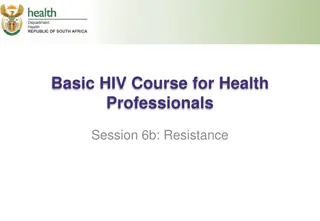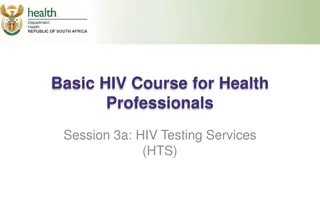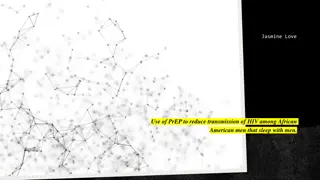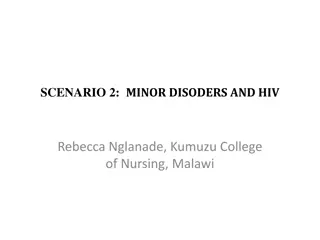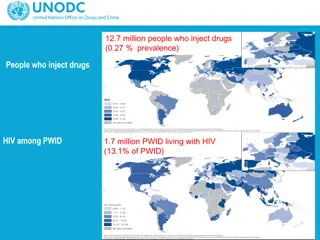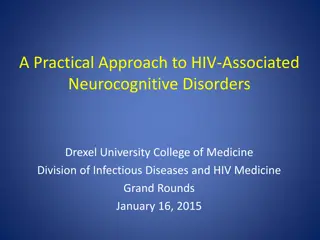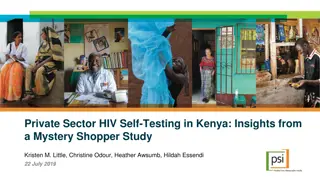Basic HIV Course for Health Professionals Session 1: Introduction to HIV
This session introduces basic epidemiological concepts, differentiates between HIV and AIDS, explains the HIV life cycle, and discusses how HIV is transmitted. Definitions of key terms like prevalence, incidence, mortality rate, and morbidity are provided. The session also highlights the differences between HIV and AIDS, emphasizing that AIDS represents the end-stage disease resulting from untreated HIV infection. The steps in the HIV life cycle are outlined, starting with the binding of the virus to CD4 receptors and the fusion with host cells to release its genetic material.
Download Presentation

Please find below an Image/Link to download the presentation.
The content on the website is provided AS IS for your information and personal use only. It may not be sold, licensed, or shared on other websites without obtaining consent from the author. Download presentation by click this link. If you encounter any issues during the download, it is possible that the publisher has removed the file from their server.
E N D
Presentation Transcript
Basic HIV Course for Health Professionals Session 1: Introduction to HIV
Learning Objectives By the end of this session participants should be able to: Define basic epidemiological concepts Differentiate between HIV and AIDS Explain the HIV life cycle Explain how HIV may be transmitted
Definitions (1) What is. . . Epidemiology? The branch of medical science dealing with the transmission and control of disease Prevalence? The number of people in a given group or population who are reported to have a disease. Incidence? Frequency of new infections expressed as a percentage of the population at risk
Definitions (2) Mortality Rate? number of deaths in a population in a given time period Morbidity? state of being diseased or unhealthy within a population Epidemic? occurs when an infectious disease spreads rapidly to many people Pandemic? epidemic occurring worldwide, or over a very wide area
What is the Difference between HIV and AIDS? HIV = virus that causes immunodeficiency AIDS = progression of HIV infection resulting from immune system destruction, leading to occurrence of disease Not everybody who has HIV has AIDS; however, everyone with AIDS does have HIV AIDS represents end-stage disease that results from untreated HIV infection
Steps in the HIV Life Cycle (1) STEP 1: Binding Attachment of GP 120 and GP41 to CD4 receptor (CCR5 or CXCR4) activates proteins on cell surface Co-receptors assist in binding of virus to CD4 receptors; facilitates fusion with cell s surface membrane and then entry into cell Following binding: Virus and CD4 cell fuse together Virus releases its contents into the CD4 T cell NB: HIV unable to make copies of its own genetic material without the assistance of another living cell
Steps in the HIV Life Cycle (2) STEP 2: Reverse Transcription Now, contents of virus are inside human cell. In this step, viral RNA converts to viral DNA. New virus DNA must find its way to host cell nucleus, and integrate with human DNA, now called proviral DNA The HIV enzyme reverse transcriptase converts the single-stranded HIV RNA to double-stranded HIV DNA
Steps in the HIV Life Cycle (3) STEP 3: Integration Transcription When cell is activated, DNA is converted to single RNA strands These go into cytoplasm; ribosomes in cytoplasm translate messenger RNA into proteins needed to form more virus Finally, a new virus is assembled - long strings of protein - cut by a viral enzyme into smaller proteins to make up new viruses
Steps in the HIV Life Cycle (4) Virus assembly Budding New viruses break free from the (human) cell, using cell s membrane to form new outer membrane of virus These new viruses can now infect new CD4 T cells.
Steps in the HIV Life Cycle (4) Viral Budding Reaction of the body to entry of HIV HIV foreign substance enters body T cells (CD4 T cells) start to respond and activate B cells which start to produce antibodies
Summary of HIV Lifecycle Virus enters body Glycoprotein GP120 binds to CD4 receptors Virus empties its contents into cell Viral RNA changes to viral DNA Viral DNA joins with cell s DNA in core of cell Transcription takes place Viral protein synthesis Viral RNA, viral proteins and enzymes assemble into more HIV New viruses break free from cell, killing it and infecting more cells
Why are Women More Easily Infected by HIV than Men? Biological make up: -Semen stays longer in vagina -More exposed surface area to partner s secretions Higher concentration of HIV in semen than in vaginal fluids Women may be unaware of erosions, STIs or open sores Dry Sex , rape, rough sex = causes tearing and bleeding Spermicides may cause allergies, irritation, inflammation Young women more prone to tearing of vaginal mucosa Failure to negotiate safer sex Low socio-economic status, socio-cultural factors
What is a Vaginal Microbicide? Substance that kills microscopic organisms such as bacteria, viruses and parasites can be inserted into vagina or rectum to destroy STIs including HIV can be in form of: gel, cream, suppository, film, lubricant, sponge or vaginal ring Researchers are still investigating whether a microbicide will ever be able to provide 100% protection against HIV
Is Being HIV Positive Related to Promiscuity? Impossible to say how many sexual contacts with infected partner/ partners are necessary before an HIV-negative person becomes HIV-positive Some partners may become infected after one sexual encounter; others may remain uninfected after several hundred exposures Several factors may contribute to chances of contracting HIV infection after a single sexual contact
Blood-to-blood Transmission Most direct way of transmitting HIV is blood to blood contact Examples include: Sharing contaminated needles, syringes or sharp instruments Occupational exposure (Needle stick injuries) Sharing tattooing and body piercing equipment This Photo by Unknown Author is licensed under CC BY-SA
What Quantity of Infected Blood Needs to be Present Before HIV is Transmitted? Impossible to say how much blood is required to transmit HIV Risk of infection depends on: Concentration of VL in blood Higher the concentration of HIV in blood, the lower the quantity of blood required to transmit virus
Infection through Unprotected Sex HIV can also be transmitted through unprotected sex, e.g.: heterosexual or homosexual anal or vaginal intercourse heterosexual or homosexual oral or anal sex
Mother to Child Transmission This can happen: during pregnancy from an infected pregnant woman to the foetus during labour and delivery, or from an infected mother to her infant through breastfeeding
Handling Bodily fluids Always take proper precautions when handling blood and any other body fluids, particularly: Blood Other body fluids containing visible blood Vaginal secretions Semen
Kissing Closed mouth or social kissing is not risky French or open mouth kissing low risk
Biting Human bite is not considered to be a likely route of HIV infection transmission, and this is even less likely because of the presence of HIV inhibitor in the saliva There has been no well documented HIV transmission through human bite
Insects HIV is not transmitted via insects blood sucking or biting insects HIV does not reproduce inside insects Even if virus enters a mosquito or other biting insect, insect does not become infected and cannot transmit HIV to next human This Photo by Unknown Author is licensed under CC BY-NC-SA
Household Transmission between family members is rare Due to skin and mucous membranes coming into contact with infected blood Follow universal precaution guidelines: Gloves Cover all wounds and sores with bandages Surfaces soiled with blood and other body fluids should be disinfected with cup JIK to 10L water Avoid sharing razors and toothbrushes
HIV and the Environment Possibility of environmental transmission is remote When HIV infected blood or other body fluids dries, risk is reduced when observed to essentially zero No one has been identified as infected with HIV due to contact with an environmental surface HIV is unable to reproduce itself outside a living host (human being)
Businesses and Other Settings No known risk of transmission from co-workers, clients or consumers in industries such as food services Routine precautions for hairdressers, barbers, cosmetologists and massage therapists Instruments that penetrate skin use once and dispose of or thoroughly clean and sterilize No known cases transmitted via tattooing or body piercing
Any Questions? Thank you!





